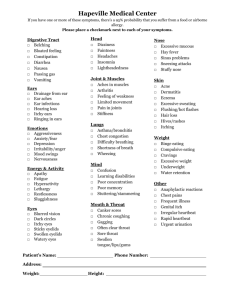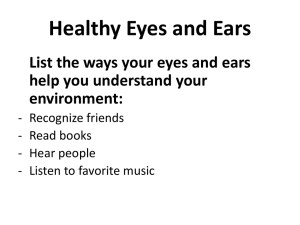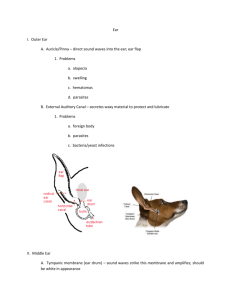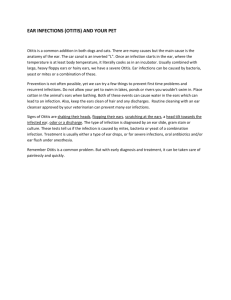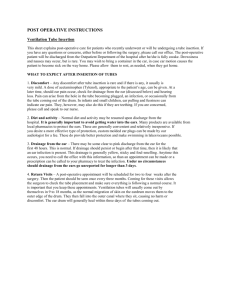Sound Show Activities - Aberdeen Science Centre
advertisement
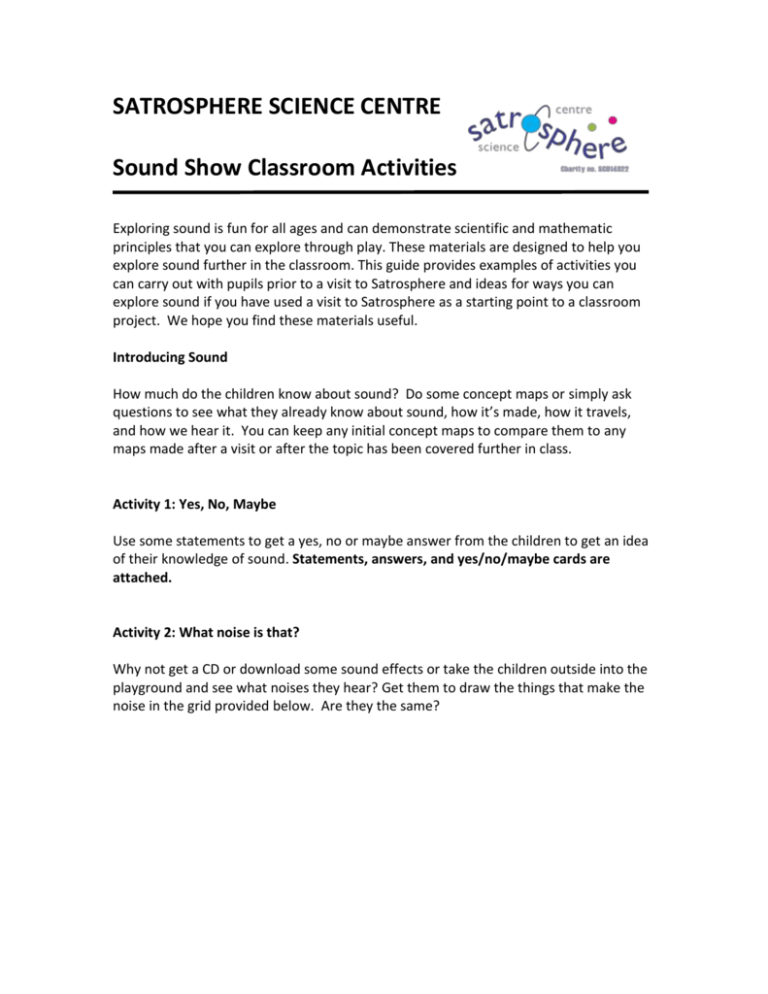
SATROSPHERE SCIENCE CENTRE Sound Show Classroom Activities Exploring sound is fun for all ages and can demonstrate scientific and mathematic principles that you can explore through play. These materials are designed to help you explore sound further in the classroom. This guide provides examples of activities you can carry out with pupils prior to a visit to Satrosphere and ideas for ways you can explore sound if you have used a visit to Satrosphere as a starting point to a classroom project. We hope you find these materials useful. Introducing Sound How much do the children know about sound? Do some concept maps or simply ask questions to see what they already know about sound, how it’s made, how it travels, and how we hear it. You can keep any initial concept maps to compare them to any maps made after a visit or after the topic has been covered further in class. Activity 1: Yes, No, Maybe Use some statements to get a yes, no or maybe answer from the children to get an idea of their knowledge of sound. Statements, answers, and yes/no/maybe cards are attached. Activity 2: What noise is that? Why not get a CD or download some sound effects or take the children outside into the playground and see what noises they hear? Get them to draw the things that make the noise in the grid provided below. Are they the same? Draw sources of sound in the squares and write what they are in the rectangles below each square. YES, NO, MAYBE cards YES NO MAYBE YES, NO, MAYBE statements 1 2 SOUND IS MADE BY SOMETHING VIBRATING 4 3 YOU CAN NOT HEAR NOISES UNDER WATER 5 THE SMALLEST BONES IN OUR BODY ARE FOUND IN THE EAR IF YOU HIT A DRUM GENTLY IT MAKES A LOUD SOUND 6 WE USE OUR EARS AND OUR BRAIN TO HEAR SOUND 7 8 LOUD MUSIC IS GOOD FOR THE EARS SOUND CAN TRAVEL THROUGH SOLID OBJECTS SOUND TRAVELS IN WAVES 9 YOU CAN HEAR ECHOES EVERYWHERE YES, NO, MAYBE answers 1) YES: All sound is made by something vibrating whether that be your voice or an aeroplane going by. 2) NO: You CAN hear noises under water. Sound travels through solids, liquids and gases. 3) NO: Hitting the drum gently causes small vibrations and a quiet noise. 4) YES: The smallest bones are called the Hammer (Malleus), Anvil (Incus) & Stirrup (Stapes) and are found in the middle ear. 5) YES: If we didn’t have our brain to process the noise we wouldn’t know what it was we were hearing. 6) YES: Sound travels through the air in longitudinal waves pushing the air forward. 7) NO: Very loud music is bad as it damages the small hairs in your inner ear. 8) YES: Sound travels through solids well as all the particles that make up a solid are very close together allowing them to vibrate much easier. 9) NO: To be able to hear an echo you need to be in a room/space with walls that can bounce the sound back to you. That is why a cave or a tunnel is the perfect place to make an echo. Activity 3: Concept cartoons There are many concept cartoons looking at sound. Below are some ideas, or you could use what the children say about sound to make your own. Children can explore the ideas in each concept and in some cases design experiments to find out if they are true. MIRROR If I shout at the mirror it reflects the sound It might reflect a bit of sound, but not very much It reflects the light but not the sound EAR TRUMPET The ear trumpet makes the sound louder The ear trumpet helps you to tell where the sound comes from You only hear sounds from one side The sounds are backwards if you turn it round Activity 4: Musical Instruments Have a range of musical instruments under a table or in a box so the children can’t see them. Play them and get the children to guess what they are. Let them then explore the instruments and find out how the instrument makes the sound. Get the children to make their own musical instruments with bits of rubbish; you can make guitars, shakers, tambourines drums, etc.. Straw reed instruments are a good way to look at pitch and how it changes with the length of the straw. See website below for example of how to make these instruments. Try snipping the end of the straw while blowing and listen to how the sound changes. http://www.doscience.com/act_archive/sept98_activity/sept98.html Activity 5: Liquid Melodies Learn how to make water music in ‘Liquid Melodies’. You may have noticed all the different sounds that water makes. This easy activity for kids creates a symphony of water. You Will Need: Bottles, jars, or drinking glasses of different sizes, water, a spoon or stick How to Make Liquid Melodies: Speaking of a symphony, here's one way to make music with water. Gather several glass bottles, jars, and/or drinking glasses of different shapes and sizes. (Always be careful when handling glass.) Put water in them - a little water or a lot. Use a spoon or a small stick to tap the containers, and see what different notes they make. Can you arrange the containers from lowest note to highest note? Can you change the level of water in the containers to create new notes? How about making up a song to play on your water instruments? Encourage the children to take the investigation further at home: Go around your house and yard, and see how many different sounds you can make with water. Drop ice cubes into a glass of water, try the faucets, from barely running to full blast. Listen to the shower, the hose, the sprinkler… Now think of water sounds in nature: a soft rain, a hard rain, waves, a waterfall. It's a regular symphony, isn't it? Activity 7: Good Listening How well do your pupils listen? Do they know how their ears work? Information about the human ear can be found at the end of this file. Why do we have two ears and why are they situated where they are? Our ears are either side of our head to help us detect where sound is coming from. Have the children close their eyes. Walk around the room talking to the children. Can they point to where they think you are? Look at some pictures of the animals listed below and have the children describe their ears (or lack thereof) and how they might hear. Animals with big ears: Foxes, Rabbits, Deer Animals with no ears: Snakes Animals that live underwater: Dolphins Activity 8: Is everyone able to hear? Not everyone is able to hear properly. This may be due to something that has happened before birth or something that happened during a persons’ life. What do these people use to help them hear? Try and invite a guest to come in to talk to the children about hearing and their ears or to teach the children some sign language. Some people have hearing dogs to help them; it might be possible to get someone to come in to show you what the dog can do. THE EAR 1) Sounds travel through the air and is collected by your outer ear, which is also called a pinna. 2) The vibrations travel into your ear and vibrate your ear drum, a thin bit of skin stretched tight like a drum. 3) The vibrating drum moves the 3 small bones inside your ear. They are called the malleus, incus and stapes (hammer, anvil & stirrup). 4) As the stapes vibrates, it moves fluid in the cochlea, which is a curled tube further inside your ear. 5) As the fluid moves, so do the tiny hairs (about 17,000 in each ear!) inside the cochlea. 6) The movement of the hairs creates electrical impulses or signals. 7) Signals from the hairs are transported to the brain by the auditory nerve. 8) In a process that is not entirely understood our brain interprets the sounds we’ve heard!
